
Fast, Versatile, and Cost-Effective FSE MR Imaging: Technical Considerations and Clinical Applications
Authors
Matthew T. Walker, MD
Shahram Partovi, MD
John P. Karis, MD
Evan K. Fram, MD
Division of Neuroradiology, Barrow Neurological Institute, St. Joseph’s Hospital and Medical Center, Phoenix, Arizona
Abstract
The development of the fast spin-echo (FSE) pulse sequence helped revolutionize magnetic resonance (MR) imaging. As its name implies, FSE imaging is faster than conventional techniques. It decreases scan time and increases patient throughput, an economically desirable situation. Shorter scan times decrease patients’ anxiety and motion. Patients’ tolerance and cooperation thereby increase and sedation requirements, in both children and adults, decrease. FSE, however, is much more than speed. The time saved can be traded for an increased signal-to-noise ratio, improved resolution, broader anatomic coverage, or supplemental sequences. FSE reduces magnetic susceptibility signal loss, which may be desirable or problematic depending on the clinical scenario. In FSE the increased signal intensity of fat is not an issue for brain imaging but is a problem for imaging of the spine and orbit. The addition of a fat saturation technique, such as chemical shift fat saturation or short tau inversion recovery, can be an effective solution. Thorough knowledge of the physics and imaging parameters of FSE permits MR radiologists to balance the need to save time against the need for supplementary sequences and unique FSE applications.
Key Words: conventional spin-echo, fast spin-echo, fat saturation technique, gradient-recalled echo, magnetic resonance imaging
Magnetic resonance (MR) imaging is well known for its superb soft-tissue contrast, multiplanar capabilities, and lack of ionizing radiation. Yet it is expensive and details bone poorly. It can also be incompatible with a variety of implants. Finally, many patients, particularly children, need sedation. Intuitively, faster MR imaging sequences would decrease total examination time, increase patient throughput and compliance, decrease the need for sedation, and decrease motion artifacts in some cases. The economic need to increase the efficiency of MR imaging contributed to the initial interest in developing faster MR imaging sequences. Once developed, certain pulse sequences were recognized as not only faster but also as having unique clinical applications and advantages.
The development of fast spin-echo (FSE, also known as turbo spin-echo) as an alternative to conventional spin-echo (CSE) has had a profound influence on MR imaging. Images acquired during FSE pulse sequences are similar to and occasionally higher quality than CSE images and can be obtained in less time. Holding time constant, FSE imaging can be used to increase the signal-to-noise ratio (SNR), resolution, or both, compared to CSE. Gradient-recalled echo (GRE) and echo planar imaging (EPI) are other rapid MR imaging sequences that have helped revolutionize MR imaging although their main benefits relate more to their unique properties and applications than to speed of imaging. This article describes the technical differences between FSE and CSE imaging and the drawbacks and benefits of the former as it relates to various clinical applications.
Technical Differences Between CSE and FSE
CSE begins with a 90º radio frequency (RF) pulse that flips protons into the transverse plane and aligns them in phase. The RF pulse is turned off, and longitudinal magnetization grows while transverse magnetization decays. At an echo time (TE) of TE/2, a 180º refocusing pulse is applied. A spin echo is then received after an additional time TE/2 for a total time of TE from the beginning of the initial 90º RF pulse. In CSE only one echo is phase-encoded per repetition time (TR). For example, a k-space with 256 lines or phase-encoding steps requires 256 TRs.
The FSE pulse sequence is a modification of the rapid acquisition relaxation enhanced (RARE) sequence described by Hennig et al.[6] FSE permits phase-encoding of multiple echoes per TR by using multiple 180º refocusing pulses per TR. The echo train length (ETL) is the number of phase-encoded echoes per TR. The theoretical time saved between CSE and FSE is determined by a factor equal to the ETL. For instance, an FSE acquisition with an ETL of 8 would decrease scan time by a factor of 8. In the clinical setting, this theoretical time-savings tends to go unrealized for two reasons: increasing the ETL decreases both the SNR and the number of slices available per TR. Multiple signal averages, increase of TR, and multiple acquisitions, all of which increase scan time, are used to improve the SNR and to increase the number of slices available. Consequently, FSE is typically two to four times faster than CSE.
FSE, however, has its own limitations and variables. Image contrast is affected by decreased susceptibility artifact, which may or may not be desirable depending on the clinical situation. Image contrast can also be altered by increased blur and ringing artifact, magnetization transfer effects, and an increased signal intensity from fat. Still, FSE has become a valid, alternative pulse sequence to CSE because it has overcome most challenges associated with contrast. In general, cerebrospinal fluid (CSF) is brighter on FSE-acquired intermediate-weighted images compared to CSE intermediate-weighted images. These potential problems are easily overcome by manipulating imaging parameters and by adding supplementary sequences while maintaining the timesaving advantage of FSE.
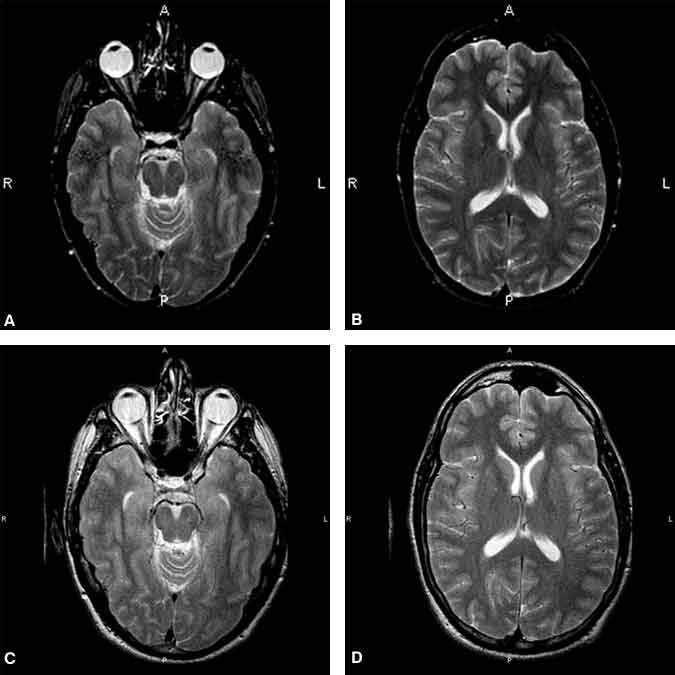
FSE Imaging of the Adult Brain
Periventricular, T2-weighted hyperintense signals from white matter, which are daily MR imaging findings, suggest pathologies ranging from microvascular disease to multiple sclerosis to the presence of human immunodeficiency virus (HIV). Maintaining image contrast between CSF and periventricular white matter is paramount, particularly on intermediate-weighted sequences. This potential problem is addressed by using a shorter ETL, which reduces the longer TE component of the FSE acquisition. A shorter ETL reduces timesavings and decreases slice coverage; the trade-off is necessary to maintain image contrast.
Ultimately, the differences in contrast obtained with FSE and CSE imaging are not statistically significant.[1,10,19,20,31] Although slight visual differences may be appreciated, their diagnostic accuracies are equivalent (Fig. 1).
For example, in 153 consecutive HIV-seropositive patients, the diagnostic accuracy of CSE and FSE was equivalent for the detection of white matter lesions.[20] Similarly, Incesu et al.8 found no statistically significant differences in the ability of CSE and FSE imaging to detect tumors and infarctions in 130 patients. Norbash et al.[19] found no differences in the two techniques for the detection of lesions with high signal intensity. Johnson et al.[10] reported similar findings in 50 consecutively randomized patients, and Tice et al.[31] reported equivalent lesion detection in 33 patients with brain tumors. Common to all these reports, however, was the almost unanimous conclusion that CSE detected small low signal intensity lesions secondary to hemosiderin and calcification better than FSE.
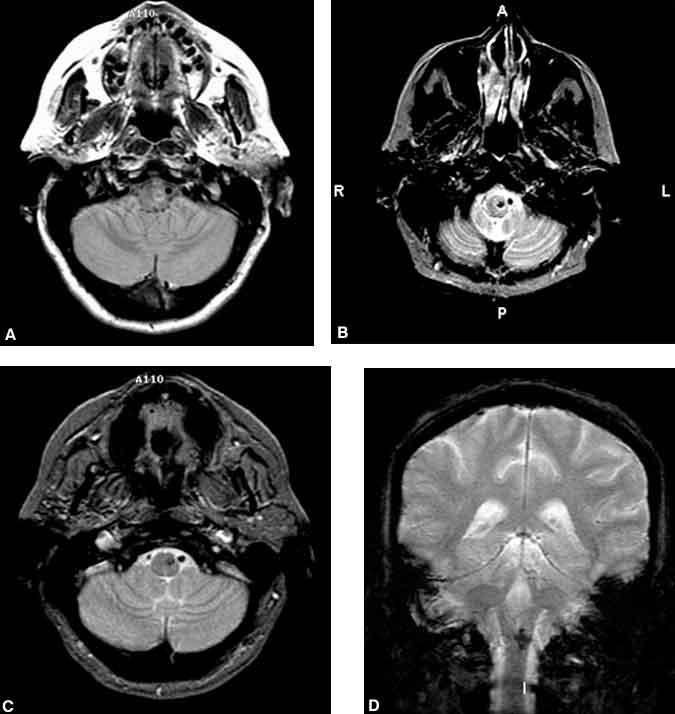
Decreased susceptibility-induced signal loss in FSE imaging is well known and regarded as a limitation in routine brain imaging. Norbash et al.[19] reported that CSE was superior to FSE imaging for detecting lesions with low signal intensity such as small hemorrhages and calcifications. Magnetic susceptibility, caused by local perturbations of the magnetic field from hemosiderin and deoxyhemoglobin, is manifested as a loss of signal intensity.[11,19] FSE is less susceptible to this effect because of the multiple 180º refocusing pulses in the ETL. In certain situations, such as the detection of small intraparenchymal hemorrhages or calcifications, the loss of signal is desirable. A common clinical scenario in which this signal loss is important would be the detection of small cavernous malformations. Because a cavernous malformation may not be surrounded by abnormal white matter, a small lesion could go undetected on FSE imaging.
The addition of a GRE sequence to the protocol more than compensates for the lost sensitivity of the FSE sequence. In fact, GRE sequences are extremely sensitive to magnetic susceptibility and provide an FSE/GRE combination that has greater overall sensitivity than CSE alone (Fig. 2).
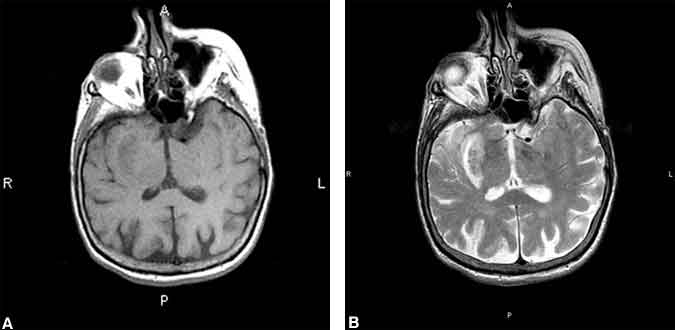
ypically, the combination FSE/GRE protocol is faster than CSE imaging alone. Moreover, this combination protocol helps detect subtle areas of shear injury in traumatized patients. If a small parenchymal hemorrhage is surrounded by any degree of vasogenic edema, the contrast is sufficient to permit detection equally well by FSE or CSE imaging (Fig. 3).[11]
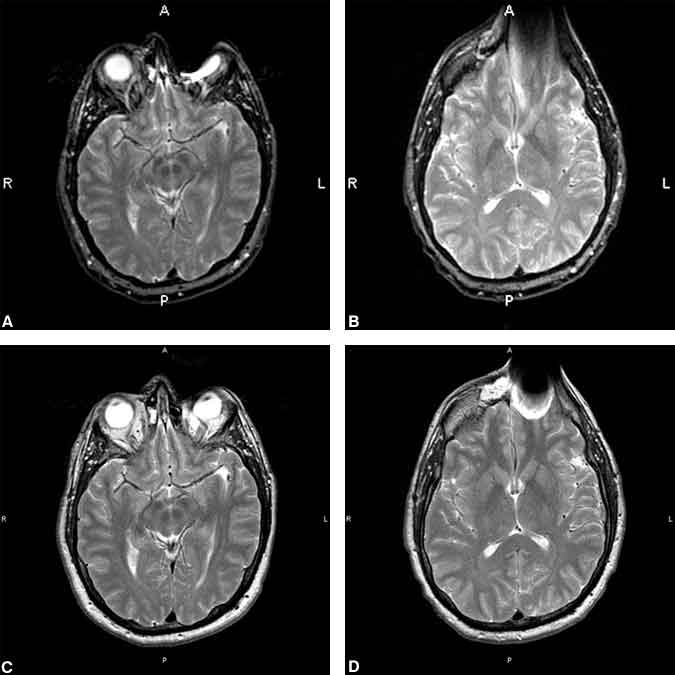
In some instances, decreased susceptibility-induced signal loss is desirable. Signal loss from braces, dental amalgams, vascular clips, shunts, metallic foreign bodies and pneumatized paranasal sinuses can be reduced by using FSE pulse sequences (Fig. 4).
Another contrast difference between FSE and CSE involves the signal characteristics of fat. Signal from fat is brighter on FSE than CSE imaging for reasons that are unclear and debated. Most authors agree that this is not clinically significant in the brain. However, the high receiver bandwidths used with FSE reduce the conspicuity of first-order chemical shifts that can be helpful in identifying fat-containing lesions. If a fat-containing intracranial lesion is suspected, troubleshooting can involve correlation with T1-weighted MR images or the use of fat suppression techniques, such as chemical shift fat saturation (CS FAT SAT) or short tau inversion recovery (STIR).
Figure 5. Axial single-shot fast spin-echo image obtained to evaluate a child for hydrocephalus. Notice the image contrast is adequate for morphological evaluation of the ventricular system. Also, decreased magnetic susceptibility artifact reduced signal loss associated with the right parietal shunt valve. No sedation was required.
FSE Imaging of the Pediatric Brain
The technical and practical benefits of FSE imaging in the pediatric population cannot be overstated. On average, shorter scan times decrease the anxiety of patients and parents, while producing more diagnostic studies less expensively. Decreased sedation helps minimize both risk and expense. Unique sequences like FSE can be used for screening purposes without exposing patients to radiation. Magnetic susceptibility artifacts from braces or shunts are decreased. FSE therefore plays a large role in pediatric neuroimaging. Common clinical scenarios include the evaluation of hydrocephalus and seizures.
Computed tomography is often used as a quick method of assessing ventricular size. In certain patient populations, such as those with congenital hydrocephalus who undergo repeated evaluations, the orbit can be exposed to a considerable dose of radiation over time.[9,17] FSE imaging permits the quick assessment of ventricular size without exposing patients to ionizing radiation. As an added benefit, FSE reduces magnetic susceptibility artifacts from shunt catheters and valves (Fig. 5). A newer technique called single-shot FSE permits the acquisition of each slice in approximately 250 ms and produces an exam of sufficient diagnostic quality[4,13] to eliminate the need for sedation.
Figure 6. High-resolution coronal fast spin-echo T2-weighted image
Pediatric patients often undergo MR imaging for the evaluation of complex partial seizures. A well-described albeit somewhat uncommon finding is hippocampal sclerosis, a condition manifested by hippocampal atrophy and increased signal intensity on T2-weighted imaging (Fig. 6). In this case, the time saved with an FSE pulse is traded to increase resolution. In both cadaveric and surgical specimens, findings of hippocampal sclerosis on FSE T2-weighted images have correlated extremely well with histologic features of abnormal hippocampi.[14,15,32-34]
FSE and CSE imaging are also equivalent for assessing the degree of myelination.[23]

FSE Imaging of the Spine
As in the brain, FSE imaging can be used to decrease scan time without sacrificing the diagnostic accuracy of spinal examinations. FSE increases contrast between the spinal cord and CSF and increases the number of slices that can be obtained, and it decreases magnetic susceptibility signal loss related to fixation devices. Using FSE to image the spine, however, increases the signal intensity of fat and artifact from CSF pulsation. It also decreases the contrast between disk material and osteophytes and magnetic susceptibility signal loss, which decreases the conspicuity of small intramedullary hemorrhages.
Statistically, contrast differences between CSE and FSE imaging of the spine are inconsequential.[2,5,21,29,35] By increasing TR, the contrast between CSF and the spinal cord can be increased significantly with only a minor increase in scan time. Selecting a TR beyond 4000 ms produces so much contrast that axial images appear myelographic. Increasing TR also increases the number of slices that can be obtained, a benefit most appreciated on axial imaging of the lumbar spine.
Decreased magnetic susceptibility signal loss is desirable when imaging the postoperative spine and when assessing spinal or foraminal stenosis. The interpretation of MR images of the postoperative spine becomes increasingly difficult in the presence of ferromagnetic hardware such as pedicle screws, rods, interbody cages, and shards from drill bits due to susceptibility-induced signal loss. FSE imaging, however, diminishes these artifacts, improving overall visualization of the spine and increasing diagnostic confidence (Fig. 7).[22,30]
Figure 8. (A) On sagittal T1-weighted imaging, high signal intensity from a conus lesion is easily identified. (B) Conventional spin-echo T2-weighted imaging shows the same lesion with a low-intensity rim indicating blood products. Although slightly less conspicuous, both the lesion and the low signal intensity of the rim are visible on (C) fast spin-echo T2-weighted images. Pathological analysis identified an ependymoma. From Partovi S, Fram EK, and Karis JP: Fast spin echo MR imaging. Neuroimaging Clin N Am 9(3):553-576, 1999. With permission from W.B. Saunders.
In contrast, GRE is exquisitely sensitive to magnetic susceptibility and therefore tends to overestimate postoperative spinal and foraminal stenosis. GRE, however, highlights areas of hemorrhage and is therefore preferred over FSE for such indications (e.g., spinal trauma) (Fig. 8).
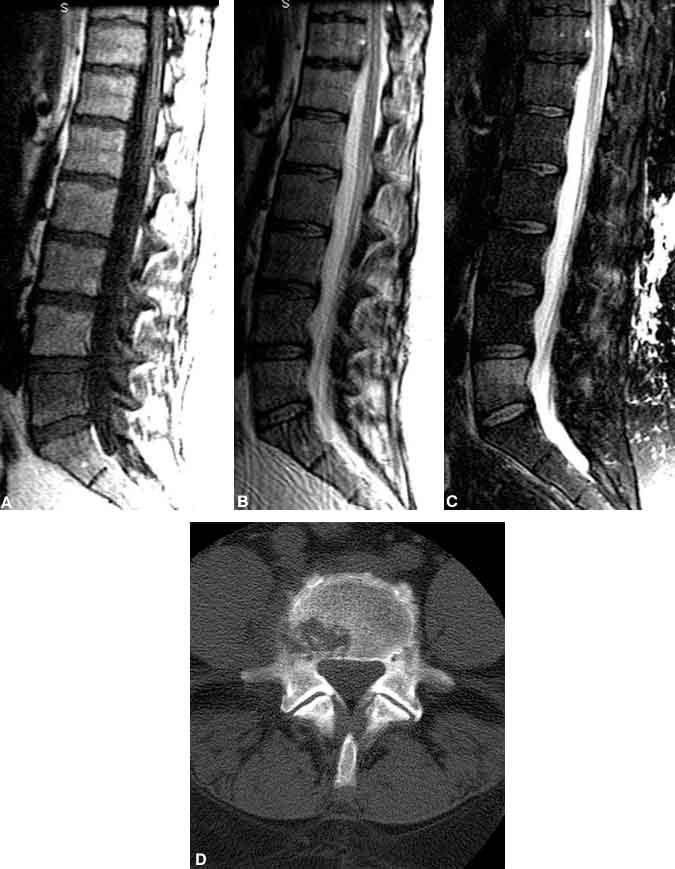
As in the brain, the signal intensity from fat on FSE pulse sequences of the spine is high. When fat appears bright, the evaluation of soft tissue and bone marrow becomes difficult. Fat-saturation techniques that selectively diminish the signal intensity from fat are not used routinely in spinal imaging, but they can be helpful for imaging spinal trauma or metastatic disease (Fig. 9).
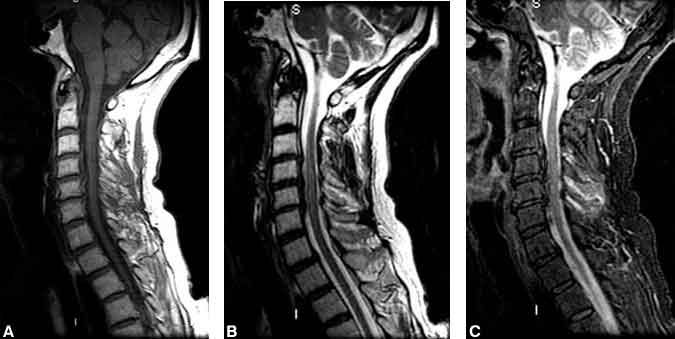
Diminishing the signal intensity of marrow permits subtle bone marrow edema, which suggests the presence of contusions or possibly fractures, to be visualized. Similarly, the detectability of soft tissue edema, which suggests ligamentous injury or disruption, is increased when the high signal intensity from fat is suppressed (Fig. 10). If a technique for diminishing the intensity of the signal from fat (CS FAT SAT or STIR) is not used, the signal from marrow can be assessed by using nonenhanced T1-weighted sequences. Lesions, however, are more conspicuous on fat-saturation and STIR FSE images than on T1-weighted images.[12]
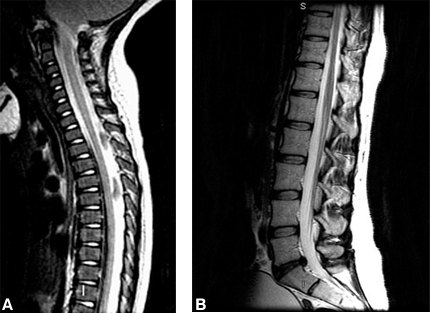
CSF pulsation artifacts are a significant detriment to effective imaging of the cervical and thoracic spine. Axial FSE images are most susceptible and usually avoided. GRE, which is insensitive to flow across the imaging plane and therefore not degraded by pulsation artifact, is the standard axial pulse sequence. GRE pulses can also help distinguish between herniated disk material and osteophytes. In the lumbar spine where pulsation is dampened, both sagittal and axial FSE T2-weighted images are used. Sagittal FSE T2-weighted images are used for the upper spine because they provide valuable information about the spinal cord even in the presence of pulsation artifact (Fig. 11).
In the pediatric spine, three-dimensional (3-D) FSE imaging can help in the evaluation of complex anomalies, including scoliosis and spinal dysraphisms.[35] Three-dimensional imaging acquires a volume of tissue that can then be reformatted for multiplanar visualization. This technique can be particularly helpful for operative planning.
FSE Imaging of the Head and Neck
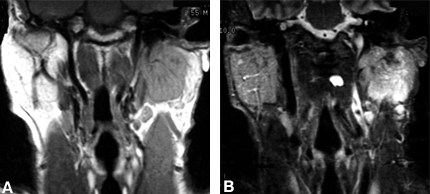
The major obstacles to diagnostic head and neck imaging are motion artifacts and the large imaging volume. Motion artifact is inevitable and may arise from swallowing, breathing, or arterial and venous pulsation. The imaging volume extends from the skull base to the thoracic inlet. FSE imaging decreases artifacts from patient motion by decreasing overall scan time. Also, the use of a longer TR permits the acquisition of more slices in less time, enabling more complete anatomic coverage.
Compared to CSE, the increase in the signal intensity of fat is a major drawback to the use of FSE imaging in the neck. Unlike the inconsequential increase in the signal intensity of fat seen with FSE imaging of the brain, many head and neck lesions have high signal intensity on T2-weighted imaging. The decreased contrast between the signal from fat and the signal from the lesion then becomes problematic.[20] The addition of a fat suppression technique (either CS FAT SAT or STIR) costs little time while improving soft-tissue contrast (Fig. 12). Effective CS FAT SAT or STIR requires a homogeneous magnetic field. In the head and neck, the magnetic field is heterogeneous because the imaging volume changes abruptly from skull base to midneck and from midneck to the thoracic inlet. This heterogeneity often produces nonuniform fat saturation at the skull base and thoracic inlet. STIR FSE is less susceptible to magnetic field inhomogeneities and thus can produce a more uniform fat suppression than CS FAT SAT. The drawbacks of STIR FSE include increased motion artifact and flow susceptibility.
Typically, either intermediate- or second echo T2-weighted images are used in head and neck imaging in conjunction with fat suppression, but not both. Instead of sharing echoes of the ETL between the data sets for intermediate- and T2-weighted images, some neuroimagers will use all of the data for the later T2 weighting. Consequently, the SNR improves and a filtering effect, which may cause edge enhancement, occurs. Some authors have suggested that edge enhancement increases the conspicuity of head and neck lesons.[16]
FSE Imaging of Miscellaneous Structures
The major potential utility of FSE imaging of the cerebellopontine angle is in evaluating vestibulocochlear schwannomas. Most departments routinely use T1-weighted imaging with and without gadolinium for this purpose. Recently, 3-D FSE has been suggested as an effective screening tool.[24-26] The cerebellopontine angle cistern and internal auditory canal are filled with CSF. The use of high-resolution FSE with a very long TR creates a myelographic effect that increases the conspicuity of small lesions against a background of bright CSF. Vestibulocochlear schwannomas are rarely cystic, and the probability of missing a lesion is low. In equivocal cases, T1-weighted images with and without gadolinium can be added.
Pituitary microadenomas classically exhibit delayed enhancement compared to normal pituitary tissue. The difference in contrast is most pronounced within 2 minutes of gadolinium injection.[7,28] The fast, dynamic nature of this process requires a fast, high-resolution technique such as T1-weighted FSE, which permits multiple high-resolution acquisitions through the same plane in a short time.[27] FSE also reduces the magnetic susceptibility-induced signal loss at the skull base that occurs as a result of multiple bone-air interfaces. The detection of adenomas increases 5 to 10% when routine pituitary imaging is combined with dynamic FSE. The trade-off for increased sensitivity to pituitary adenomas is decreased specificity. In autopsy studies, as many as 27% of pituitary glands may be associated with an incidental pituitary lesion of 1 to 2 mm.[3] A third of these lesions are adenomas; Rathke’s cleft cysts are common among the remainder.
Orbital imaging would be impossible without an FSE fat-saturation technique, which is superior to CSE imaging for several reasons. As in the sella turcica, there is reduced magnetic susceptibility signal loss when FSE is used near interfaces such as the sinuses.[18] Artifacts from motion and chemical shift are reduced.[18] Finally, scan time can be traded for increased resolution of small intraorbital structures. As in the head and neck, fat saturation can suffer from magnetic field inhomogeneity caused by the aerated paranasal sinuses. STIR FSE, which is widely used in orbital imaging, can help to alleviate this artifact, but the trade off is an increase in motion artifact.
Conclusion
FSE MR imaging is a fast, cost-effective sequence associated with diagnostic image quality. Knowledge of the unique imaging properties of FSE allow MR radiologists to harness its power effectively.
References
- Burtscher IM, Owman T, Romner B, et al: Aneurysm clip MR artifacts. Titanium versus stainless steel and influence of imaging parameters. Acta Radiol 39:70-76, 1998
- Chappell PM, Glover GH, Enzmann DR: Contrast on T2-weighted images of the lumbar spine using fast spin-echo and gated conventional spin-echo sequences. Neuroradiology 37:183-186, 1995
- Elster AD: High-resolution, dynamic pituitary MR imaging: Standard of care or academic pastime? AJR Am J Roentgenol 163:680-682, 1994
- Feinberg DA, Kiefer B, Johnson G: GRASE improves spatial resolution in single shot imaging. Magn Reson Med 33:529-533, 1995
- Gillams AR, Soto JA, Carter AP: Fast spin echo vs conventional spin echo in cervical spine imaging. Eur Radiol 7:1211-1214, 1997
- Hennig J, Nauerth A, Friedburg H: RARE imaging: A fast imaging method for clinical MR. Magn Reson Med 3:823-833, 1986
- Ikami I, Abe S, Katto K, et al: [Dynamic MR imaging of the pituitary gland by the fast spin echo (RARE) sequence] (Japanese). Nippon Igaku Hoshasen Gakkai Zasshi 53:1076-1078, 1993
- Incesu L, Gunes M, Akan H, et al: MRI of the intracerebral lesions at 0.5 Tesla: Comparison of fast spin-echo and conventional spin-echo sequences. Comput Med Imaging Graph 20:105-113, 1996
- Jackson A, Whitehouse RW: Low-dose computed tomographic imaging in orbital trauma. Br J Radiol 66:655-661, 1993
- Johnson BA, Fram EK, Drayer BP, et al: Evaluation of shared-view acquisition using repeated echoes (SHARE): A dual-echo fast spin-echo MR technique. AJNR Am J Neuroradiol 15 :667-673, 1994
- Jones KM, Mulkern RV, Mantello MT, et al: Brain hemorrhage: Evaluation with fast spin-echo and conventional dual spin-echo images. Radiology 182:53-58, 1992
- Jones KM, Schwartz RB, Mantello MT, et al: Fast spin-echo MR in the detection of vertebral metastases: Comparison of three sequences. AJNR Am J Neuroradiol 15:401-407, 1994
- Keller PJ, Drayer BP, Fram EK, et al: A prepared single-shot scanning method yielding T2 contrast and high resolution on a conventional MRI scanner. Proc Soc Magn Reson 1:492, 1994
- Kim JH, Tien RD, Felsberg GJ, et al: Fast spin-echo MR in hippocampal sclerosis: Correlation with pathology and surgery. AJNR Am J Neuroradiol 16:627-636, 1995
- Lee N, Tien RD, Lewis DV, et al: Fast spin-echo, magnetic resonance imaging-measured hippocampal volume: Correlation with neuronal density in anterior temporal lobectomy patients. Epilepsia 36:899-904, 1995
- Lewin JS, Curtin HD, Ross JS, et al: Fast spin-echo imaging of the neck: Comparison with conventional spin-echo, utility of fat suppression, and evaluation of tissue contrast characteristics. AJNR Am J Neuroradiol 15:1351-1357, 1994
- Maclennan AC, Hadley DM: Radiation dose to the lens from computed tomography scanning in a neuroradiology department. Br J Radiol 68:19-22, 1995
- Mukherji SK, Tart RP, Fitzsimmons J, et al: Fat-suppressed MR of the orbit and cavernous sinus: Comparison of fast spin-echo and conventional spin-echo. AJNR Am J Neuroradiol 15:1707-1714, 1994
- Norbash AM, Glover GH, Enzmann DR: Intracerebral lesion contrast with spin-echo and fast spin-echo pulse sequences. Radiology 185:661-665, 1992
- Olson EM, Healy JF, Wong WH, et al: MR detection of white matter disease of the brain in patients with HIV infection: Fast spin-echo vs conventional spin-echo pulse sequences. AJR Am J Roentgenol 162:1199-1204, 1994
- Peh WC, Siu TH, Chan JH, et al: Lumbar spine magnetic resonance imaging: Comparison between fast spin echo proton density and spin echo T1 axial scans. Br J Radiol 71:487-491, 1998
- Petersilge CA, Lewin JS, Duerk JL, et al: Optimizing imaging parameters for MR evaluation of the spine with titanium pedicle screws. AJR Am J Roentgenol 166:1213-1218, 1996
- Prenger EC, Beckett WW, Kollias SS, et al: Comparison of T2-weighted spin-echo and fast spin-echo techniques in the evaluation of myelination. J Magn Reson Imaging 4:179-184, 1994
- Renowden SA, Anslow P: The effective use of magnetic resonance imaging in the diagnosis of acoustic neuromas. Clin Radiol 48:25-28, 1993
- Shelton C, Harnsberger HR, Allen R, et al: Fast spin echo magnetic resonance imaging: Clinical application in screening for acoustic neuroma. Otolaryngol Head Neck Surg 114:71-76, 1996
- Soulie D, Cordoliani YS, Vignaud J, et al: MR imaging of acoustic neuroma with high resolution fast spin echo T2-weighted sequence. Eur J Radiol 24:61-65, 1997
- Stadnik T, Spruyt D, van Binst A, et al: Pituitary microadenomas: Diagnosis with dynamic serial CT, conventional CT and T1-weighted MR imaging before and after injection of gadolinium. Eur J Radiol 18:191-198, 1994
- Stadnik T, Stevenaert A, Beckers A, et al: Contrast behavior between microadenoma and normal pituitary gland after gadolinium injection as a function of time at 1.5 T. Neuroradiology 34:184-189, 1992
- Sze G, Merriam M, Oshio K, et al: Fast spin-echo imaging in the evaluation of intradural disease of the spine. AJNR Am J Neuroradiol 13:1383-1392, 1992
- Tartaglino LM, Flanders AE, Vinitski S, et al: Metallic artifacts on MR images of the postoperative spine: Reduction with fast spin-echo techniques. Radiology 190:565-569, 1994
- Tice HM, Jones KM, Mulkern RV, et al: Fast spin-echo imaging of intracranial neoplasm. J Comput Assist Tomogr 17:425-431, 1993
- Tien RD, Felsberg GJ: The hippocampus in status epilepticus: Demonstration of signal intensity and morphologic changes with sequential fast spin-echo MR imaging. Radiology 194:249-256, 1995
- Tien RD, Felsberg GJ, Campi de Castro C, et al: Complex partial seizures and mesial temporal sclerosis: Evaluation with fast spin-echo MR imaging. Radiology 189:835-842, 1993
- Tien RD, Felsberg GJ, Crain B: Normal anatomy of the hippocampus and adjacent temporal lobe: High-resolution fast spin-echo MR images in volunteers correlated with cadaveric histologic sections. AJR Am J Roentgenol 159:1309-1313, 1992
- Weinberger E, Murakami JW, Shaw DW, et al: Three-dimensional fast spin echo T1-weighted imaging of the pediatric spine. J Comput Assist Tomogr 19: 721-725, 1995
